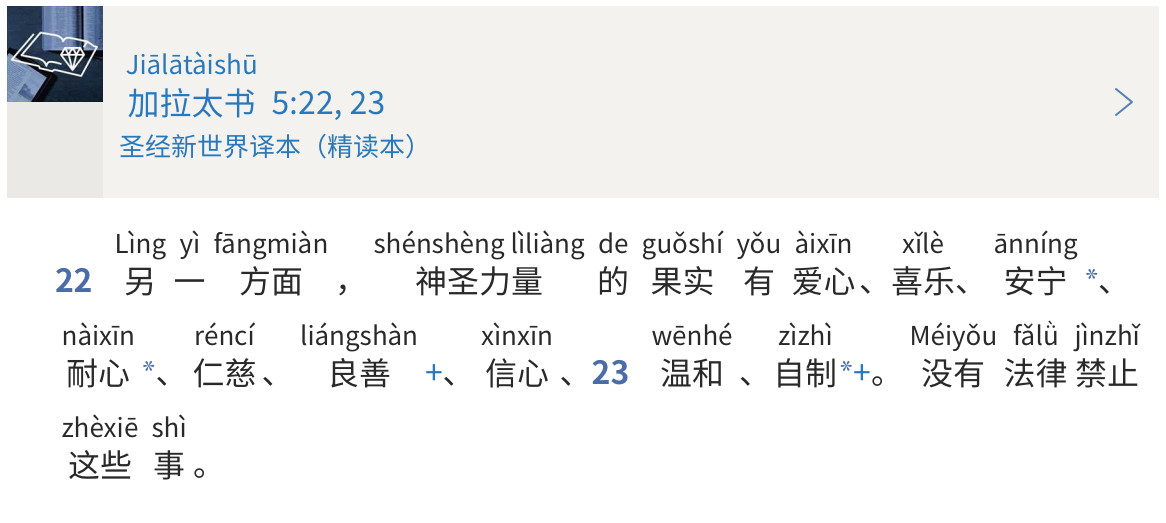liángshàn ({[is] good} [→ [goodness]] 良善) ← Tap/click to show/hide the “flashcard”
The sixth part of the fruitage of the spirit listed is goodness.— Jiālātàishū (Jiālātài·shū Galatia · Book → [Galatians] 加拉太书 加拉太書) 5:22, 23.

The English word “goodness” is translated into Mandarin in the above scripture as “liángshàn ({[is] good} [→ [goodness]] 良善)”, this week’s MEotW.
Note that the Pīnyīn (Pīn·yīn {Piecing Together} · Sounds → [Pinyin] 拼音) Plus information for “liángshàn ({[is] good} [→ [goodness]] 良善)” (← tap/click to show/hide the “flashcard”) shows that when put together in this context, both of the morphemes that make up “liángshàn ({[is] good} [→ [goodness]] 良善)” individually basically mean “good” or “goodness”, and so the resulting whole word also means “good” or “goodness”.
Of the two morphemes that make up “liángshàn ({[is] good} [→ [goodness]] 良善)”, “shàn ({[is] good [at]} [→ [charitable; kind; friendly; virtuous]] 善)” is sometimes used as a word on its own, but the other morpheme “liáng (good; fine; desirable; virtuous (bound form) 良)” is not used as a word on its own—it’s what’s known as a bound form.
Bound Forms
The ABC Chinese-English Dictionary, edited by John DeFrancis and Victor H. Mair, among others, tells us the following about the entries in it that are marked as bound forms:
B.F. (Bound Form, Niánzhuó Císù 粘着词素).
Morphemes which do not function as free words in a sentence and cannot be handled using one of the other bound category labels, such as prefix, suffix, measure word, or particle. A given character may represent a free word in one or more of its meanings but a bound morpheme in other meanings. E.g. qiǎng 抢 is a bound form meaning ‘take emergency measures’ in qiǎngshòu 抢收 but a free form as a verb meaning ‘pillage’.)
In addition to these meaningful bound forms, which we define and illustrate with one or more examples, there are many characters which have no meaning of their own but simply represent a syllabic sound. E.g. 8pú 葡 and 6táo 萄 in pútao 葡萄 ‘grapes’. For these entries we provide neither entry label nor definition but simply note words in which the character occurs.
The Monosyllabic Myth
This seems to be a good place to mention the Monosyllabic Myth. This is the mistaken belief that in Chinese, every word is monosyllabic (one syllable), represented by a character, and that conversely, every syllable is a word.
One factor that contributes to this mistaken belief is that unlike how words are obviously separated by spaces in English writing, the Chinese characters writing system puts all characters the same distance apart from each other regardless of word boundaries—the main units below sentences seem to be characters, not words. Another contributing factor is that in good old paper Chinese dictionaries, the main entries are each based on a single character, not on a single word, which may contain more than one syllable—while English dictionaries are dictionaries of words, traditional Chinese dictionaries have been dictionaries of characters.
The Reality of Mandarin Syllables
The reality, though, as newer Chinese dictionary apps like Pleco make obvious, is that in Mandarin there are syllables like “liáng (good; fine; desirable; virtuous (bound form) 良)”, which is not a word on its own, but which combine with other syllables to form words like “liángshàn ({[is] good} [→ [goodness]] 良善)”, which have two or more syllables. While text written in Chinese characters all runs together into a single hard-to-parse mass, Pīnyīn (Pīn·yīn {Piecing Together} · Sounds → [Pinyin] 拼音) text uses word separation to clearly show word boundaries, like how in the above image it’s clear that “liángshàn ({[is] good} [→ [goodness]] 良善)” is a separate word from the words before and after it.
John DeFrancis, in his book The Chinese Language: Fact and Fantasy (pp. 184–185), explains the different types of syllables in Mandarin, with regard to how free they are to stand on their own as words:
DEGREES OF SYLLABIC FREEDOM
Syllables like wǒ that are intelligible even in isolation are at the opposite extreme from syllables like hù, allegedly “butterfly” but actually a mere phonetic element devoid of meaning and tightly bound as part of the two-syllable expression hùdiǎr. Between these two extremes are meaningful syllables that are semibound in the sense that they always occur bound but have a certain flexibility in joining with other syllables. There are thus three types of Chinese syllables:
- F: free, meaningful
- SB: semibound, meaningful
- CB: completely bound, meaningless
These three categories are roughly comparable in English to the free form teach, the semibound form er in “teacher” and “preacher,” and the completely bound forms cor and al in “coral.”